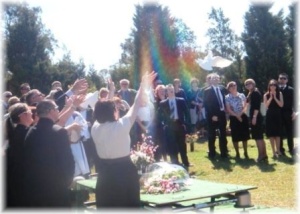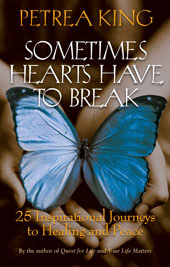
Photo courtesy http://www.peterjjackson.com
Princess Diana had the most publicized funeral in history. It was broadcast worldwide. The most powerful part was the eloquent and moving eulogy delivered by her brother, Charles Spencer. At one point he said, “I don’t think she ever understood why…there appeared to be a permanent quest on (the media’s) behalf to bring her down….Of all the ironies about Diana, perhaps the greatest is that a girl given the name of the ancient goddess of hunting was, in the end, the most hunted person of the modern age.”
Great eulogies make great funerals. Of course, it’s absurd to think of a funeral as great, but some are memorable. Eulogies can be remarkable, moving experiences for speakers and audience members. You might assume eulogies are as common as flowers at memorial services. Unfortunately, this is not so. Not all families are able to find someone who is willing and able to write and deliver a eulogy. Some funerals go without; others rely on clergy who may not have known the deceased. The results can be disappointing.
None of us likes to contemplate the loss of a loved one or the call to duty to deliver a eulogy. Reading this article now, however, you will gain a brighter perspective on this task and discover the benefits of the writing process as a healing tool
What A Eulogy Should Accomplish
There are two common misconceptions about the purpose of a eulogy. Some people think 1) it should be an objective summation of the person’s life; or 2) the eulogy should speak for everyone who is present at the memorial service. These are unrealistic assumptions.
A eulogy is much more simple. Of course, it can include information about the person’s life, but primarily it should express the feelings and experiences of the person giving the eulogy vis-à-vis the loved one. The most touching and meaningful eulogies are subjective and written from the heart. Aeulogy does not have to be perfect. Whatever you write and deliver will be appreciated by the people in attendance. If you are inclined to be a perfectionist, lower your expectations and just do what you can, given the short time-frame for preparation and your fragile emotional state.
When you set out to write a eulogy, realize the burden does not have to be yours alone. Ask friends and relatives for their recollections and stories. In a eulogy, it is perfectly acceptable to say, for example, “I was talking to Uncle Lenny about Ron. He reminded me of the time Ron came to Thanksgiving dinner with half of his face clean-shaven and the other half fully-bearded. It was Ron’s unique way of showing he had mixed feelings about shaving off his beard.”
Be honest. For most people, there are a lot of positive qualities to talk about. Once in a while, however, a eulogy has to be given for someone with mostly negative traits. If that is the case, omission is the solution. A eulogy is not a confession. No one will find fault if you leave out negative details. Talk about positive qualities and, if you must mention the negative, try to put a compassionate spin on it. For example, “She struggled with her demons and they sometimes got the best of her.”
Tips For Delivering A Eulogy
A eulogy may be the most difficult speech you ever deliver, but it may also be the most rewarding. Calm yourself by realizing that people are not going to judge you. They will be very supportive. No matter what happens, it will be okay. If you need to cry in the middle of your speech, everyone will understand. Take a moment to compose yourself, then continue. Don’t be embarrassed. Remember, giving a eulogy is a noble gesture that people will appreciate, admire, and remember.
If you can, make the eulogy easy to read. On a computer, print out the eulogy in a large type size. If you are using a typewriter, put extra carriage returns between the lines. If you are writing by hand, print the final version in large letters and give the words room to breath by writing on every second or third line.
Before the memorial service, consider getting a cup of water. Keep it with you during the service. When you go to the podium, take the water in case you need it. Sipping water before you start-and during the speech, if needed-will help relax you.
Before delivering the eulogy, breath deeply and remind yourself that you are surrounded by loving friends and family. They are with you 100 percent. If you would find it easier, read the eulogy without looking up to make eye contact with the audience. Take your time. Do the best you can. Just be yourself.
Writing As Therapy
Writing in general-a eulogy, a letter, a journal-presents a valuable opportunity to discover a new therapeutic tool to help you deal with grief, sadness, ambivalence, confusion or other needs for change. On some level, you already know how therapeutic writing can be. At one time you may have written an angry letter and not mailed it, but felt better for having written it. In the case of a eulogy, writing brings up memories, rekindles feelings, and acts as a catalyst. It has been said, “The only way out is through.” Writing helps you revisit emotions that are important to the healing process, so get your feelings on paper. You do not have to be grieving to use writing as a tool to help you gain clarity on an issue or to motivate yourself to make changes in your life.
There are many ways to use writing to deal with your loss. Some people keep journals or diaries; others write letters. Some people send e-mail to friends; others write poems or stories. There is no right answer. Experiment. Do what works for you.
Julia Cameron, in her book, The Artist’s Way, tells aspiring artists to set aside time each morning to write. She calls it, “morning papers.” You can call it, “mourning papers.” Every morning take the time to write three pages of thoughts and feelings. Write long-hand rather than using a typewriter or computer because there is a better connection between the hand and the heart. While writing, don’t concern yourself with spelling, grammar, punctuation, being redundant, or making sense. Write half-baked ideas, thoughts, or feelings if you want. The goal is not to write something good or something that will ever be read again. The goal is to write simply for the sake of getting it out of your system.
Mourning papers can cover anything-complaints, dreams, frustrations, feelings, and so on. Nothing is too trivial. Complain about the barking dog next door. Write about your life’s dreams or sorrows. Create a grocery list. Brainstorm goals. Unburden yourself of pain, sorrow, fears, and regrets. You can think long-term and create a better life for yourself or you can work on immediate needs. The only rule is there are no rules. Let whatever is on your mind flow onto the paper.
This is a very powerful exercise during which you will make several discoveries:
*The process is enjoyable.
*Your thoughts will flow quickly and the important ones will be pushed to the surface with great force.
*It is easy to fill up three pages.
*You might have to stop to cry, especially if you are mourning or in pain.
*The process frees you of petty complaints and obsessions.
*You will look forward to these morning writing sessions.
Bringing up the pain, although unpleasant, is part of working through it. I’m not a therapist, but from experience I know that repressing feelings is counter-productive. Shakespeare once wrote, “Tears water our growth.” The power of writing is undeniable and there is no better time than now to take advantage of it.
Writing and delivering a eulogy is a noble gesture that is worthy of thought and effort. It is an opportunity to make a contribution to a memorial service-a contribution that you, your friends and family will long remember. Think of a eulogy as a gift to yourself and others. Embrace the opportunity to brighten an otherwise dark time.
Garry Schaeffer is the author of “A Labor of Love: How To Write A Eulogy.” This 96-page book has helped thousands of people since 1995. It includes: a “How-To” section with writing tips and short-cuts; sample eulogies of famous people, including Gandhi, John F. Kennedy, Martin Luther King, Jr., Princess Diana and others; poems for memorial services; and much more. http://www.eulogybook.net
Article and photo courtesy www.peterjjackson.com
When you create a Lifebook for your loved one, you can upload the audio eulogy from the funeral so that people who ere unable to attend can hear the eulogy and you ill have it stored for years to come.










